If you want to add molding and trim work to your new construction home (or to customize your current home), but aren’t fully sure of what options you have, this post is for YOU! Incorporating interior trim and molding makes a HUGE custom home design statement!
By the end of this post, you’ll feel confident in understanding your trim options AND communicating to your builder what type of trim/molding you want in your new home!
Below is: (1) an explanation of the difference between trim and molding, (2) a comparison of two popular trim material options, (3) an overview of the most common trim work options, and (4) my ONLY frustration with trim work (just to prepare you).
FYI: this is a lengthy post so you can just skip down to the info you need (see subheadings)!
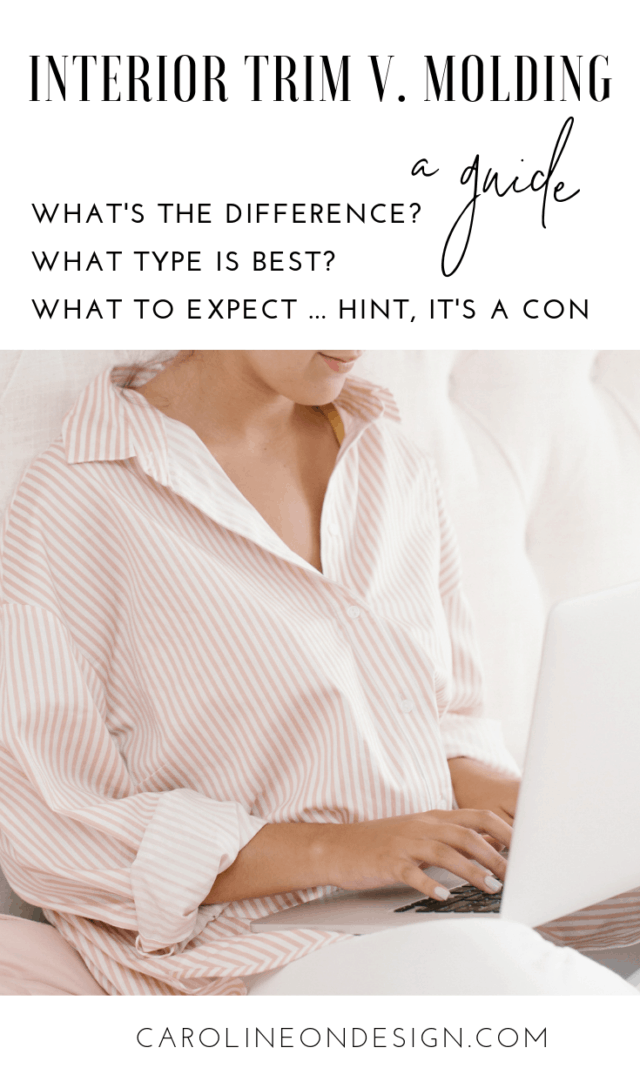 Affiliate links are used for your shopping convenience. Please read my full disclosure policy for more info!
Affiliate links are used for your shopping convenience. Please read my full disclosure policy for more info!
WHAT’S THE DIFFERENCE BETWEEN MOLDING AND TRIM?
This is a common question, and the answer is pretty simple. TRIM is a general term that refers to all molding in a home (i.e. window casing, door casing, baseboards, etc.).
MOLDING (or moulding) is a broad classification of millwork (any type of woodwork that is produced in a mill … typically decorative) in the home that adds non-structural details (or ornamentation) and beauty to a room.
Honestly, you can use these words interchangeably! Molding, trim, millwork … they all kinda mean the same thing (IMO)!
WHICH IS BETTER: MDF OR SOLID WOOD MOLDING?
First of all, there are other materials (e.g. PVC, engineered wood, etc.) that can be used for your home’s molding. I could (and will eventually) write a WHOLE blog post on just molding material options!
In this post, however, I’ll just compare two of the most popular options: MDF and solid wood.
MDF
MDF (Medium Density Fiberboard) is a VERY popular choice in many homes … primarily because it is easy to work with and very economical (as compared to solid wood)!
MDF is machine made, so the pieces come in uniform sizes and shapes. This eliminates time searching for uniform solid wood pieces. MDF also can bend which makes it easier to install on walls that aren’t entirely flat.
MDF does have some downfalls: it’s more prone to damage (from nicking) than solid wood molding, it doesn’t work well in high-moisture areas (e.g. your bathroom), and it requires more care than wood during installation.
SOLID WOOD
Solid wood molding is another popular choice, but does come with a much higher price tag!
It is the most natural option for your home … however, with NATURAL comes imperfections! Solid wood bulges and warps, so it can be time-consuming to find pieces that are consistent in size and shape. Wood also has a tendency to split (whereas MDF does not). Surprisingly, it can be easier to install than MDF.
WHICH IS BETTER?
There is NO wrong choice! Both materials have pros and cons … so it really comes down to your preference, the elements (e.g. humidity in room), and (especially) your budget!
We have a mix of both solid wood and MDF trim throughout our home! You can mix and match the materials based on BUDGET and ROOM (i.e. don’t use MDF in high humidity rooms)! Honestly, I didn’t even know we had a mix (until my husband just told me), SO it’s obvious that your guests will NEVER know you have a mix … they’ll be too busy gushing over your gorgeous trim!
Let’s move on to types of molding …
POPULAR TYPES OF MOLDING
BASEBOARD
A baseboard is the molding installed where the bottom of your wall meets the floor. The main job of a baseboard is to provide a transition from the floor to the wall. Baseboards can be as simple or intricate as you would like!
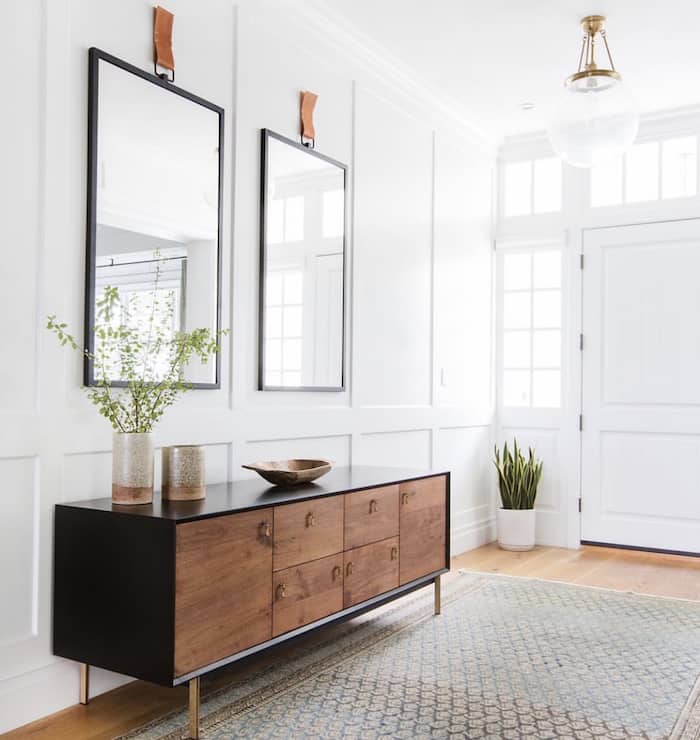
BASEBOARD, CROWN + WAINSCOT | AMBER INTERIORS
CROWN MOLDING
Crown molding is basically the opposite of a baseboard; it is the molding installed where the top of your wall meets the ceiling. Many homes do not have crown molding because of the added expense, but it definitely is a great finishing touch in ANY room! Crown molding can be super simple or extremely ornate … and anywhere in between!
WINDOW CASING
Window casing is the functional (and decorative) molding used to frame your windows.
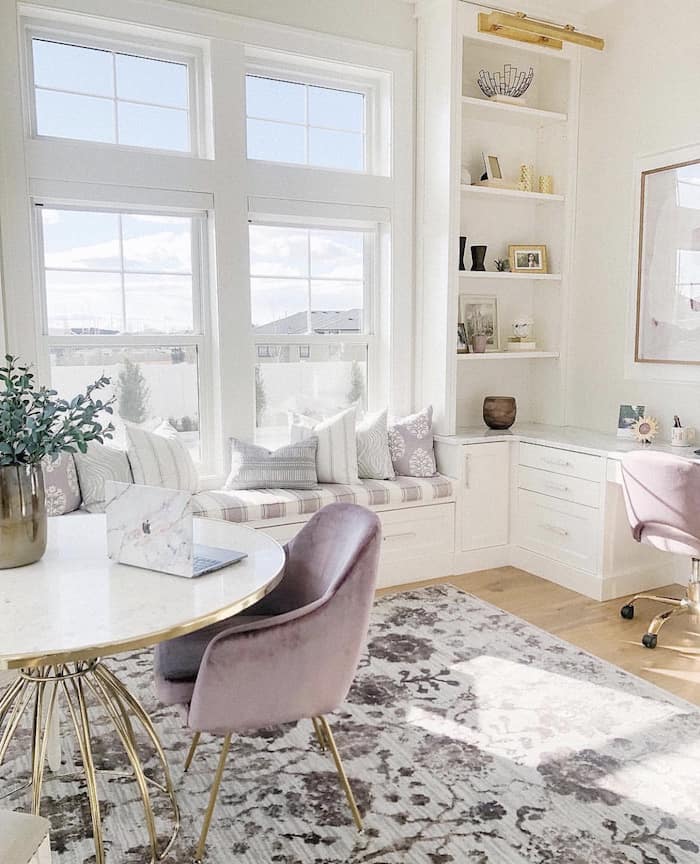
WINDOW CASING | SITA MONTGOMERY INTERIORS
DOOR CASING
Door casing is the functional (and decorative) molding used to frame your doors.
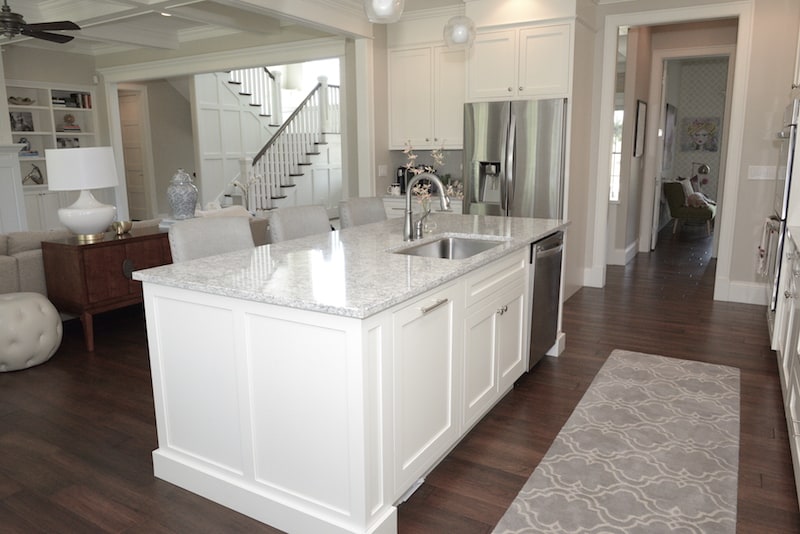
DOOR CASING AND BOARD + BATTEN IN MY HOME | RUG RUNNER
CHAIR RAIL
A chair rail is a wall molding installed about three feet above (and parallel to) your floor. Chair rails were originally used to protect walls from damage by chairs. This is still a functional aspect in some cases, but overall chair rails are now used as a decorative accent.
WAINSCOTING
Wainscoting is a broad term that refers to any decorative paneling used on a wall. The original purpose of wainscoting was: to prevent damage to walls, to cover up wall damage, to provide extra insulation, and as a decorative accent.
Wainscoting typically covers the lower third of the wall, but also looks gorgeous when it covers two-thirds of the height of the wall! Some people even cover their entire wall with wainscoting … and it looks stunning!
Wainscot is still used as a protective measure against wall damage, but it is primarily used as a decorative accent in homes. It comes in MANY styles and is usually capped at the top with a chair rail. The most common styles of wainscoting that we hear about are board and batten, beadboard, flat-panel, and raised-panel.
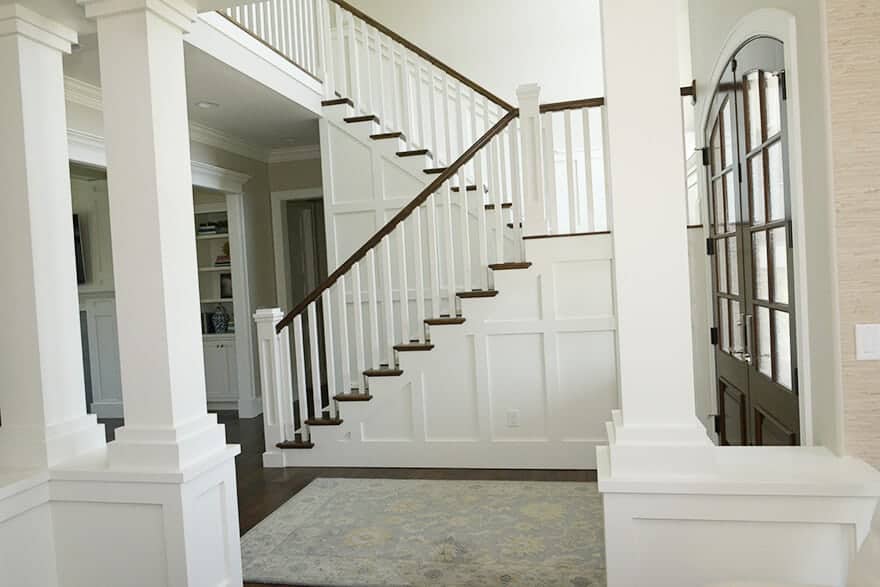
WAINSCOT ON MY STAIR WALLS | SIMILAR RUG
BEADBOARD
Beadboard is a type of wainscoting and is often used in rooms as a protective measure (and also adds visual interest). It tends to be very durable and can be installed at any height you want.
Beadboard is made up of thin vertical boards that are capped off by a strip of horizontal molding (similar to a chair rail) … and there is a little indention between each board (this is referred to as a ‘bead’).
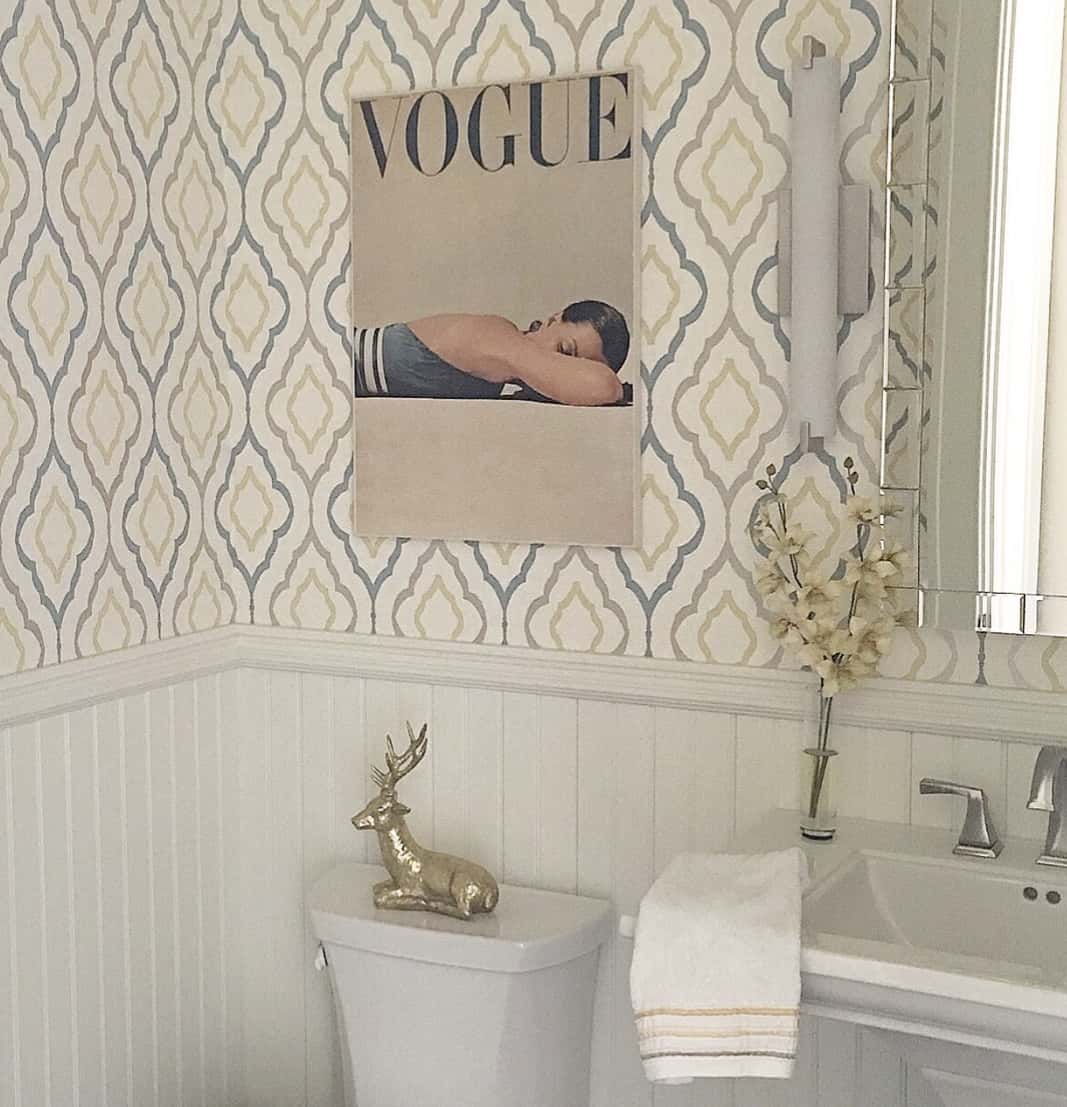
BEADBOARD IN MY POWDER ROOM | WALLPAPER | SCONCE | PEDESTAL SINK | SINK HARDWARE
BOARD AND BATTEN
Board and batten is another type of wainscoting. It consists of several wide boards that alternate with a small strip called a “batten”. Today, board and batten is primarily used to add a decorative element to homes (both interior and exterior)!
TRAY CEILING
A tray ceiling features a recessed center ceiling that is about a foot higher than the ceiling around the perimeter of the room. It is primarily a decorative feature in any style of home, but a tray ceiling is also functional in that it can hide ductwork (e.g. we added a tray ceiling to hide ductwork in our basement).

TRAY CEILING IN MY KITCHEN | ISLAND PENDANTS | WOOD FLOORING | BACKSPLASH | TABLE PENDANT
COFFERED CEILING
A coffered ceiling is another decorative feature used in homes. It is a series of sunken panels that are typically in the shape of a square (but can be in an octagon or any other shape as well).
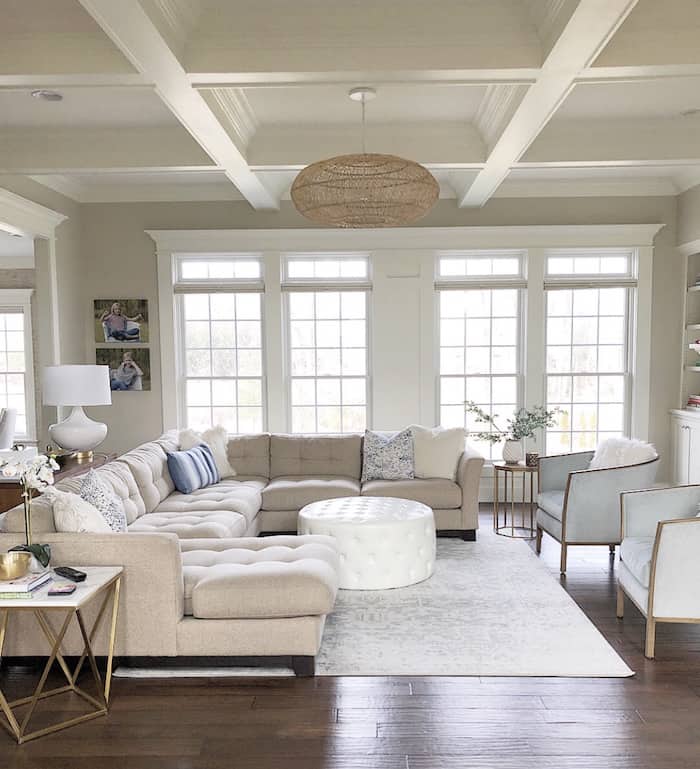
COFFERED CEILING + WINDOW CASING IN MY FAMILY ROOM | PENDANT | SIDE TABLE | RUG
SHIPLAP
Shiplap is vertical boards that fit together in a way so that each board overlaps (or basically rests on) the one below it. It was made UBER popular by Joanna Gaines … it’s still quite trendy today and has been for years!
TONGUE AND GROOVE
Tongue and Groove looks very similar to shiplap when installed on the wall; however, the vertical boards join together and interlock. Honestly, I can’t tell the difference between shiplap and tongue and groove … there I admitted it! They are both equally beautiful!
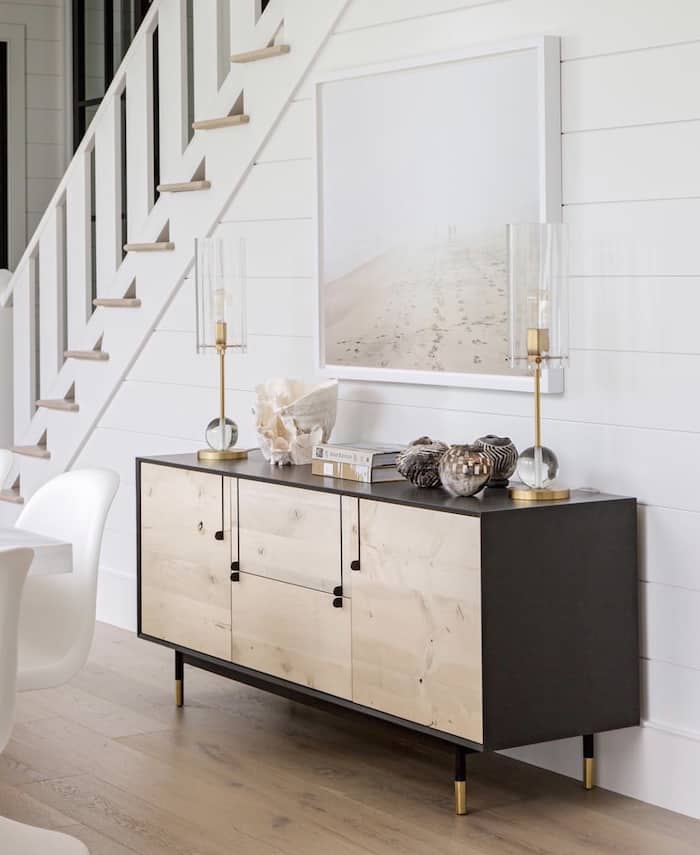
TONGUE AND GROOVE (OR SHIPLAP!)| JENNY KEENAN DESIGN | PHOTO: JULIA LYNN PHOTOGRAPHY
A TRIM WORK NEGATIVE
There is the ONE negative to trim work (and it is the ONLY negative other than cost) … your gorgeous trim work will crack. A LOT (sniff sniff)! Cracking with custom trim work is normal … REALLY frustrating … but normal!
I live in a harsh climate that is high in humidity and has extreme temperature shifts, so our house might expand and contract more than homes in mild climates.
This expansion and contraction (year after year) causes our trim to crack … it makes me so sad to see cracks in our beautiful moldings! The first year was the worst (extensive cracking), and now it is certainly milder. We have our painter come back once a year and fill in the cracks and do touch up painting.
I just want you to be aware that this is something to expect with trim work.
CONCLUSION
We covered the following in this post: (1) an explanation of the difference between trim and molding, (2) a comparison of two popular trim material options, (3) an overview of the most common trim work options, and (4) my ONLY frustration with trim work (hint … the cracking).
I hope you now feel more confident in understanding your interior trim and molding options, AND in communicating to your builder what type of trim you want in your new home!
If you are building a home and looking for answers to other design questions, I have MANY more posts re: BUILDING A HOME! If you have a design dilemma that isn’t covered on my blog, please comment below!

I really appreciated this post Carrie and thanks for keeping it real about the cons, but seems like it’s worth the maintenance for all the beauty 🙂 I love how informative your posts are!
Can you explain your mix of MDF and wood? Where do you have which material? We live in the Midwest too and are trying to consider our options. Can you tell the difference if you use different materials in adjacent rooms? Thanks!
Hi Rachel! We have wood trim on door frames, window frames, crown, and baseboards. We used MDF to create the wainscoting on our stairwalls and to create the posts and columns in our dining room. We used both wood and MDF within the same rooms. To be honest, I had NO idea we even had a mix because it all just flows!
[…] https://carolineondesign.com/a-guide-to-interior-trim-and-molding/ […]
Hi Caroline. I have a question for you. I hope you can help! We have the more formal type of mounding on the bottom half of our dining walls in our townhome. The area of the kitchen right next to the dining area (it is an open area) we installed vertical shiplap around the island ang continued around the bar going into the living room. Looks very nice, however, our question to you is, do these wood accents go together or conflict? I think it looks n ie, my husband in the other hand isn’t sure. Thank you! Kristin
Hi Kristin! I wouldn’t worry about whether or not the trim work ‘goes together or conflicts’. If you like how it looks together, then keep it! It’s your home. However, if your husband is questioning how it looks, you might want to get a second opinion from friends or family who will actually see the trim work. It’s hard for me to say without seeing what it looks like :).
I found this very useful. Nice article!
http://www.chicagotrimandmoldingpros.com
Is a Coffered ceiling made of wood or another product?? Also, is it “built” piece by piece or “prefab”?
Hi Deb! It all depends on how you want to do your coffered ceiling and, more importantly, your budget. It can be created with MDF or wood. I am not an expert in how coffered ceilings are built, so I would talk to a local carpenter or your builder about this.
[…] words molding and trim are terms that you probably hear a lot from contractors and designers, but is there a difference between the […]
[…] Trims and moldings are used to lessen the contrast between the walls and ceilings. It softens the lines and edges between these spaces, creating a subtler and more graceful appearance. […]
How did you paint your coffered ceiling? Semi gloss white in the trim and flat white on the ceiling?
[…] Trims and moldings are used to lessen the contrast between the walls and ceilings. It softens the lines and edges between these spaces, creating a subtler and more graceful appearance. […]
What parts of the trim are cracking and what type of trim do you have? A lot of times the cracking comes from what materials were used and how they were installed.